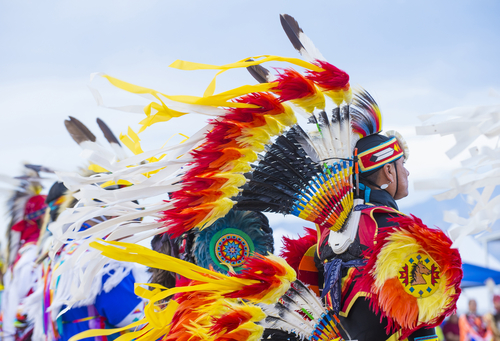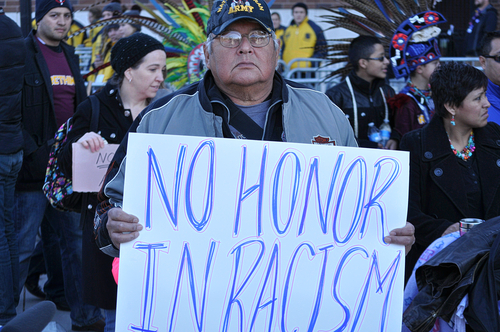
Southwestern Tribes in the 21st Century
Module 13
In this course we have learned about various Native American groups that live in the southwestern United States. We have examined their relationships with the environment, their backgrounds, their ancestral lifestyles, and how their cultures have changed and continue to evolve. We have considered how European contact and the policies of the United States government have impacted their lifestyles and examined some of the major issues faced by tribes today. Today, nearly five centuries after the arrival of Europeans, most southwestern Native Americans retain a strong sense of tribal identity and connection with the landscape of their ancestors. At the same time they are American citizens who also function within the external (state, national, and international) world in which they live. In this module, we examine the status of southwestern Native American tribes in the 21st century, and compare their efforts to achieve self-determination with those of other indigenous people throughout the world.

Native American dancers at at the Annual Paiute Tribe Pow Wow held in Las Vegas, 2015.
http://www.shutterstock.com/s/Paiute+pow+wow/search.html?page=1&thumb_size=mosaic&inline=197877389
Click next page to continue.
Southwestern Native Americans, like indigenous people throughout the world, are engaged in a struggle for self-determination. Self-determination refers to the right of a people to determine their own economic, social and cultural developments; that is, to control their own affairs within their own territories. It does not, however, mean disengagement from the larger society or necessarily reflect a desire on the part of the indigenous people to secede from the larger political entity of which they are a part.
Indigenous people are descendants of the people that inhabited a region prior to its colonization by others. World-wide, many indigenous people maintain distinct identities and cultures from that of the dominant society under which they live. Additionally, many indigenous people are economically and politically disadvantaged compared to the dominant society as a result of the processes of colonization. In these ways they are similar to that of ethnic minorities; but unlike ethnic minorities, they continue to live in the homeland of their ancestors.
By virtue of their ancestral ties to the landscape, many human rights organizations recognize certain rights of indigenous people to their territories, lands, and resources. Today, indigenous people are mobilizing on an international scale through organizations such as the World Council of Indigenous Peoples (WCIP), which works to advance the rights of indigenous people. Through the efforts of the WCIP, in 2006 the United Nations approved a Declaration on the Rights of Indigenous Peoples, a nonbinding statement endorsing the right of indigenous people to self-determination and control over their territory and resources.
In recent decades, federal policies towards Native Americans have mirrored the growing international recognition of the rights of indigenous peoples. As discussed in Module 2, in the United States many Native American groups have limited legal sovereignty as a result of treaties that they signed with the federal government in the 18th century (see Module 2 for a review of this concept). However, these sovereignty rights are limited to those tribes covered by treaties and to reservation lands. In the remainder of this module, we will discuss other federal laws, policies, and Native American concerns having to do with the rights of Native Americans in American society.
|
Navajo family, Winslow, Arizona Source - Shutterstock ID: 269716796 |
Children playing on the Navajo reservation Source - Shutterstock ID:192603653 |
Click next page to continue.
 Tension has often existed between tribal and state governments, particularly in relation to the federal protection of Indian rights within state boundaries. This tension is perhaps most evident in the realm of Indian gaming.
Tension has often existed between tribal and state governments, particularly in relation to the federal protection of Indian rights within state boundaries. This tension is perhaps most evident in the realm of Indian gaming.
In response to cutbacks in federal funding to tribes, in the early 1980s several tribes opened gaming operations on their reservations. After witnessing the economic success of these early operations additional tribes soon followed suit. Afraid of losing lottery revenues to Indian-owned casinos, several states attempted to force the closure of these casinos but invariably lost in court. Realizing that they could not halt Indian gaming, the states (supported by Nevada's casino industry) pressured Congress to regulate the casinos. The result was the Indian Gaming Regulatory Act, passed by Congress in 1988. This act, which represents a balance between the rights of tribes and that of states, recognizes the rights of tribal gaming but allocates regulatory jurisdiction over different classes of gaming among tribal, federal, and state government.
As a result of the growth in Indian gaming, many tribes are experiencing unprecedented economic growth and independence. Monies from gaming are being used to fund other tribal economic ventures and to improve housing, education, and medical care. However, the economic benefits of gaming vary greatly from tribe to tribe, with some tribes (particularly those not located near population centers) benefitting little or none from this activity.
Click next page to continue.
 Perhaps the most contentious issue in the Native American struggle for self-determination is the disposition of ancient Native American burials. Concerned about the large numbers of Native American human remains being housed in museums across the country, tribes began to vocally demand their return in the 1970s and 1980s. Their efforts were rewarded on November 16, 1990 with the enactment of the Native American Graves Protection and Repatriation Act (NAGPRA). This federal law has three provisions. First, it requires museums that receive federal funds to return any Native American human remains or "cultural objects" in their possession to Indian tribes. (For the purposes of NAGPRA, cultural objects are defined as funerary offerings, sacred offerings, or objects of cultural patrimony). Second, it vests Native Americans with the ownership of any human remains or cultural objects discovered on federal lands after 1990. And finally, it makes it illegal to sale or purchase Native American human remains and cultural objects.
Perhaps the most contentious issue in the Native American struggle for self-determination is the disposition of ancient Native American burials. Concerned about the large numbers of Native American human remains being housed in museums across the country, tribes began to vocally demand their return in the 1970s and 1980s. Their efforts were rewarded on November 16, 1990 with the enactment of the Native American Graves Protection and Repatriation Act (NAGPRA). This federal law has three provisions. First, it requires museums that receive federal funds to return any Native American human remains or "cultural objects" in their possession to Indian tribes. (For the purposes of NAGPRA, cultural objects are defined as funerary offerings, sacred offerings, or objects of cultural patrimony). Second, it vests Native Americans with the ownership of any human remains or cultural objects discovered on federal lands after 1990. And finally, it makes it illegal to sale or purchase Native American human remains and cultural objects.
NAGPRA has not been without controversy. Some scientists argue that the human remains and objects are part of all of our patrimony, and should be accessible for scientific study. Others argue that the law is well intentioned, but that it should not extend to ancient remains for which no direct linkage to a tribe can be established. Other scientists, however, believe that the improved communication with tribal members that has resulted since the implementation of the law has benefitted anthropology and other scientific disciplines.
Click next page to continue.
NAGPRA gave Native Americans control over the remains of their ancestors and of certain types of objects. However, it does nothing to protect Native American landscapes or sacred areas. Some protection, however, is given by the American Indian Religious Freedom Act (AIRFA) and by the concept of Traditional Cultural Properties embedded in the National Historic Preservation Act.
The American Indian Religious Freedom Act (AIRFA), passed in 1978, states that "….. it shall be the policy of the United States to protect and preserve for American Indians their inherent right of freedom to believe, express, and exercise the traditional religions….. including but not limited to access to sites, use and possession of sacred objects, and the freedom to worship through ceremonial and traditional rites." Through a series of court rulings, it has been established that this law generally requires federal agencies to consult with tribes about anything that might affect their religious practices, but that the law does not compel the agencies to protect those practices or their sacred sites.
|
The construction of Lake Powell in 1963 resulted in the submersion of a prayer spot used by Navajo medicine men. AIRFA, passed in 1978, was designed to limit the destruction of areas needed for Native American religious practices. However, the law falls short of mandating their protection.
Source - Shutterstock Image ID - 66105643.
|
The National Historic Preservation Act, passed in 1966, was designed to encourage the preservation of properties of historic or cultural importance. This very broad law contains many provisions, one of which requires federal agencies to follow a set of procedures designed to minimize damage to such properties. Any project conducted on federal lands or with federal funds or permits must go through a vetting process before it can be approved. This process is designed to ensure that reasonable efforts are made to avoid causing damage to important properties, including those considered to be traditional cultural properties.
A traditional cultural property is defined as one that is valued by a particularly community for the role that it plays in sustaining that community. Such properties are important in community traditions and are generally well known through oral histories. As with the American Indian Religious Freedom Act, a traditional cultural property does not receive automatic protection. Actions that damage or even destroy such a property may still be approved, but they must first go through a rigorous vetting process intended to minimize thoughtless decision-making. Several properties discussed in this class can be considered traditional cultural properties, including Blue Lake for the Taos (see Module 3), Red Butte for the Havasupai (see Module 9), and Spirit Mountain for the Southern Paiute (see Module 12).
|
Mount Graham, located in southeastern Arizona, is home to an observatory complex operated by the University of Arizona. It is also a traditional cultural property important to the Western Apache, who believe that the gaan, or mountain spirits, reside there. The Western Apache have fought the construction of new observatory facilities on the mountain, arguing that the facilities desecrate the home of the mountain spirits.
Source - https://en.wikipedia.org/wiki/File:Mt_graham_2008.JPG |
Practice Quiz # 13